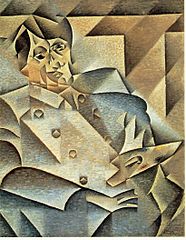Whats It Called When Art Is Broken Up Into Different Parts
Fine art History and Artists
Cubism
History >> Art HistoryGeneral Overview
Cubism was an innovative art movement pioneered by Pablo Picasso and Georges Braque. In Cubism, artists began to look at subjects in new ways in an effort to describe iii-dimensions on a flat canvass. They would pause up the subject into many unlike shapes and then repaint it from different angles. Cubism paved the style for many different modern movements of art in the 20th century.
When was the Cubism movement?
The movement started in 1908 and lasted through the 1920s.
What are the characteristics of Cubism?
There were two main types of Cubism:
- Analytical Cubism - The first stage of the Cubism move was chosen Analytical Cubism. In this style, artists would study (or analyze) the subject field and break it up into unlike blocks. They would look at the blocks from dissimilar angles. And so they would reconstruct the subject field, painting the blocks from various viewpoints.
- Synthetic Cubism - The second stage of Cubism introduced the idea of adding in other materials in a collage. Artists would use colored paper, newspapers, and other materials to represent the dissimilar blocks of the subject. This phase also introduced brighter colors and a lighter mood to the art.
This is an early case of Belittling Cubism. In the painting y'all can run into the broken up pieces of the violin and the candlestick. Many different angles and blocks of the objects are presented to the viewer. Braque said that this style allowed the viewer to "go closer to the object." You can run into this picture here.
Iii Musicians (Pablo Picasso)This painting by Pablo Picasso was one of his later works in Cubism and is an case of Synthetic Cubism. Although information technology looks similar the picture is fabricated out of cutting upwardly pieces of colored paper, it is actually a painting. In the painting it is difficult to tell where one musician ends and the next begins. This could represent the harmony of the music as the musicians play together. You can see this movie here.
Portrait of Picasso (Juan Gris)Cubism was also used to paint portraits. In this example of Analytical Cubism, Juan Gris pays tribute to the inventor of Cubism Pablo Picasso. Like many early Cubism paintings, this painting uses cool dejection and light browns for colors. The lines between the different blocks are well divers, only Picasso's facial features can nonetheless be recognized.

Portrait of Picasso
(Click paradigm to come across larger version)
Famous Cubism Artists
- Georges Braque - Braque is one of the founding fathers of Cubism along with Picasso. He continued to explore Cubism for much of his art career.
- Robert Delaunay - Delaunay was a French artist who created his own way of Cubism called Orphism. Orphism focused on vivid colors and the relationship betwixt painting and music.
- Juan Gris - Gris was a Spanish artist who became involved in Cubism early on. He also was a leader in the development of Synthetic Cubism.
- Fernand Leger - Leger had his own unique fashion inside Cubism. His art began to focus on popular subjects and was an inspiration to the creation of Pop Fine art.
- Jean Metzinger - Metzinger was a artist and writer. He explored Cubism from a scientific standpoint as well equally an artistic one. He wrote the first major essay on Cubism. Some of his famous paintings include The Passenger: Woman with a Equus caballus and Woman with a Fan.
- Pablo Picasso - The primary founder of Cubism, together with Braque, Picasso explored a number of different styles of art throughout his career. Some say that he produced plenty innovative and unique art for five or six dissimilar famous artists.
- The artwork of Paul Cezanne is said to take been one of the main inspirations for Cubism.
- Picasso and Braque did non retrieve Cubism should be abstract, only other artists, such as Robert Delaunay, created more than abstract piece of work. In this mode Cubism eventually helped to spawn the Abstract Fine art movement.
- Picasso also worked on Cubist sculpture including his sculpture Caput of a Woman.
- Pop subjects for Cubism included musical instruments, people, bottles, glasses, and playing cards. There were very few Cubist landscapes.
- Pablo Picasso and Georges Braque worked closely together in developing this new art form.
Take a 10 question quiz almost this page.
Works Cited
History >> Art History
Source: https://www.ducksters.com/history/art/cubism.php
Post a Comment for "Whats It Called When Art Is Broken Up Into Different Parts"